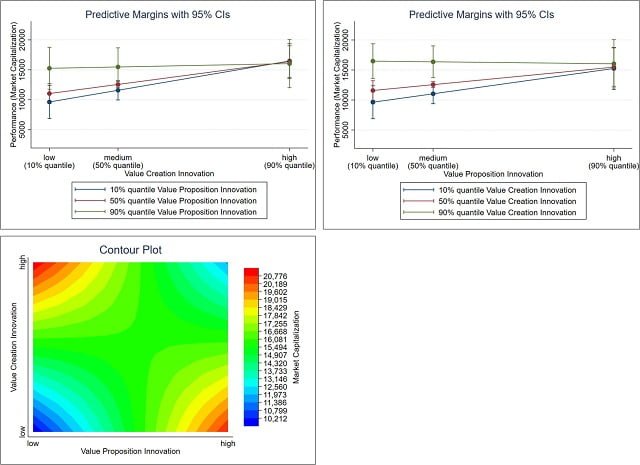
In the ever-evolving landscape of today’s business world, staying at the forefront is a constant challenge. A key strategy that has garnered significant attention is Business Model Innovation (BMI). Despite the increasing interest in BMI, there has been a lack of concrete empirical evidence regarding its long-term impact.
To fill this gap, a team of researchers from Friedrich Schiller University Jena, Nordhausen University of Applied Sciences, and Witten/Herdecke University examined the effects and distinctions of three dimensions: value creation, value proposition, and value capture. In other words: How is value created? What is the promised value? How is this value measured?
The study aims to bridge this gap by delving into a comprehensive analysis based on a study that adopted an element-based perspective, focusing on the three core dimensions.
Understanding Business Model Innovation
Business Model Innovation is not a one-size-fits-all concept; it refers to the adaptation or redesign of business models that can influence a company’s success. These changes can provide significant competitive advantages to companies. Especially in the case of startups, it is evident that modifying the business model correlates positively with a company’s success.
However, for established businesses, the consequences of innovations in business models are more complex and less obvious. These changes can have profound impacts: company processes may need fundamental restructuring, market positioning may shift, or even existing business segments may be affected or replaced. This requires a reassessment of resource allocation.
The Study
The study was based on a comprehensive data collection involving the analysis of over 35,000 press releases. It covered more than 2,300 BMI events from 60 publicly traded German companies, which were then compared with fixed performance metrics.
Subsequently, the researchers correlated this data with firm performance measures to uncover the nuanced effects of business model innovation over time.
Findings and Impact Over Time
The findings, published in the Journal of Business Research, reveal a positive effect of business model innovation on firm performance, even if this effect occurs with a time delay.
The study’s results paint a compelling picture of the relationship between BMI and business performance, indicating a positive, albeit delayed, effect of business model innovation on company performance. This implies that the benefits of innovating one’s business model may not be immediately apparent but can significantly influence performance in the long run.
However, the authors have identified that different parts of a business model can have both positive and negative effects. It is essential to note that a company may develop better if it focuses its efforts on specific dimensions rather than distributing them equally among many.
Concentration vs. Dispersion: Strategic Insights
One particularly intriguing discovery is the comparison between concentrated and dispersed BMI activities. The research indicates that concentrated BMI activities, where innovation efforts are focused on specific dimensions, outperform activities dispersed across various dimensions. This emphasizes the importance of strategic resource allocation in the realm of business model innovation.
Implications for Strategic Management
These findings contribute significantly to the existing literature on business model innovation, prompting a deeper reflection on the role of resource allocation.
The study underscores the need for careful planning and strategic management when engaging in BMI activities. For businesses looking to thrive in a rapidly evolving environment, understanding the intricate dynamics of value creation, proposition, and capture is paramount.
The authors note that their study paves the way for future research. In the upcoming period, attention will be focused on investigating how different dimensions of business model innovation align or could potentially replace each other. This will take into account resource allocation and underlying thinking. These insights could facilitate more effective resource utilization and smarter strategic decisions for business model innovation.
Conclusion
In conclusion, as businesses navigate the complexities of the modern market, adopting innovation in business models emerges as a strategic imperative.
The publication of this study contributes to a better understanding of business model innovation and its effects on companies. The insights provide valuable perspectives for both managers and researchers, opening new avenues for future research in this field.
The empirical evidence presented in this study not only validates the positive impact of BMI on company performance but also provides valuable information for companies looking to optimize their approach to innovation.
As the business landscape continues to evolve, those who master the art of business model innovation are poised to achieve sustained long-term success.
Reference (Open Access):
Matthias Menter, Lutz Göcke, Christopher Zeeb, Thomas Clauss. 2023. Disentangling the complex longitudinal relationships between business model innovation and firm performance, Journal of Business Research, Volume 168, 2023, 114229, ISSN 0148-2963, https://doi.org/10.1016/j.jbusres.2023.114229.
Editor and founder of “Innovar o Morir” (‘Innovate or Die’). Milthon holds a Master’s degree in Science and Innovation Management from the Polytechnic University of Valencia, with postgraduate diplomas in Business Innovation (UPV) and Market-Oriented Innovation Management (UPCH-Universitat Leipzig). He has practical experience in innovation management, having led the Fisheries Innovation Unit of the National Program for Innovation in Fisheries and Aquaculture (PNIPA) and worked as a consultant on open innovation diagnostics and technology watch. He firmly believes in the power of innovation and creativity as drivers of change and development.





